There is a wide and interesting range of food in Japan and if you are earning
yen, much of it is quite cheap. Even for the tourist though, if you have some
idea where to look, you can find many affordable options and experience quite a
lot without breaking the budget. Guide books usually list restaurants but
cheaper options are often convenience stores, places offering all you can eat
(they do exist!) and the Japanese equivalent of the pub, Izakaya. The challenge
therefore can be your willingness to enter shops where you can't read the signs,
or if you aren't that brave, many places have displays of plastic food or
pictures on the menu and you can hold up your fingers to indicate how many you
want.
If you are staying for a while, supermarkets are a good option. The trolleys
are about the same size as a western shopping basket and you will most likely
not have a car and therefore have to drag bags home on the train, so shopping
every few days becomes a necessity. There are also lots of specialty shops such
as pharmacies, fruit shops and 100yen shops (daily goods) where prices are
comparable to supermarkets. When I worked at NOVA I tried to continue my Australian tradition of
shopping only once a week, but gave up after a while as I had to walk a fair way
home and the savings living in a share house weren't really that much. After a while,
I ended up buying lunch and tea and only eating breakfast at home.
While working at AEON and living by myself I did a lot more cooking. There
was a supermarket across the road eliminating the tiresome walk and I was a lot
more familiar with the ingredients, ways of cooking and I could read everything. I
was able to save a lot of money cooking for myself.
Cereal and bread were what I missed most the first time. Both are available, but are highly
sugared and full of preservatives. The bread range is very limited and sold in
lots of slices, rarely loaves. Cereal is imported, loaded with sugar and very
expensive. If you can, import it, take it with you or get used to a Japanese
breakfast! The second time I went I started eating salmon, rice and natto for
breakfast and found it kept me full longer. I kept eating these after coming
back to Australia, but salmon and natto are very expensive!
One danger spot- much of the food is highly carbo-loaded, sugary or deep fried.
This of course makes it very attractive but many people gain not loose weight
when going there. I also noticed a big change in the size of Japanese people in
the space of the three years I was away, with obesity not nearly as uncommon as
it had been. The ease of going to the convenience stores plus the cheapness
of snack foods can be a real trap. Find someone to teach you proper
cooking and be prepared to spend money on fruit and vegies which can seem shockingly
expensive when you first arrive.
My favourites:
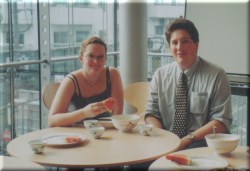 |

|
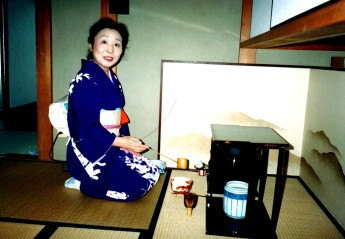 |
| Watermelon: highly delicious but extremely expensive. Expect
to pay up to $150 for a gift boxed one. Generally bought by the slice so
if you are given any, be appropriately grateful and don't tell them you
can buy them for a few dollars in Oz! |
I was lucky to be able to go into people's homes and be
cooked for! This meal included salad, fried chicken pieces, assorted
noodle dishes, deep fried prawns and omelettes. |
Tea ceremony- I
was invited to a house which had a
traditional tea room and took part in the ceremony. The tea is quite
bitter but is accompanied by very sweet little cakes. The event focuses on
the tradition, not the food so watch carefully as to how to hold your cup
and what order to do things in. |
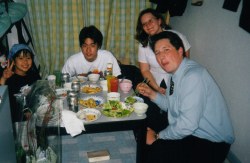 |
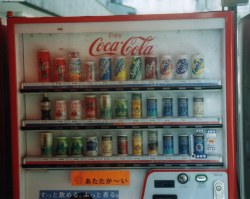 |
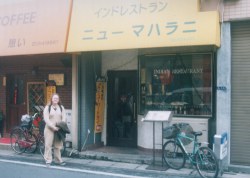 |
| If you can find some friends, they will often cook for you!
Kae cooked a great dinner, no mean feat given that the flat only had one
hotplate! The food was wonderful, but the pain from
sitting on the floor is a bit distracting! |
Vending machines- you can buy amazing things here, some
unmentionable! There is about one vending machine for every 6 people, so
they are not hard to find! Even in supposedly 'remote' areas, you are
never stuck for a cold drink. In winter, they serve hot drinks and a favourite
is canned coffee. |
My very favourite- the Indian 'New Maharani', a place that
had all you can eat lunches and I certainly did! Also a favourite with Nova
teachers as it was close to work and the staff spoke English. |
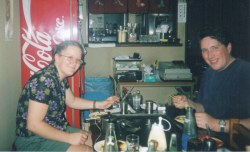 |
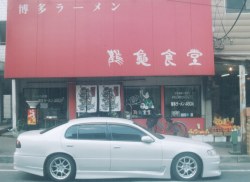 |
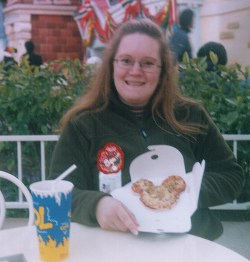 |
| Okonomiyaki-The raw ingredients are bought from a
menu and can include various kinds of meat, fish and vegetables. They are
pre-chopped and only need to be mixed and cooked. The table is a big grill
so you can cook to your own taste then season with mayonnaise, dried fish,
herbs and a sweet brown sauce. |
This is a ramen shop. Ramen are
noodles served in soup with vegetables and meat. They are often
accompanied by rice or gyoza (dumplings). This shop was close to where I lived so
I frequently went there and the waitress would bring us favourites without needing to be asked. Note the big plastic bowl of ramen
out the front. A meal set was approximately AUS$10 and was more than enough. |
This tiny pizza and drink from Disney Land cost
about AUS$15. Disney land is a wonderful place but unless you earn yen it is
too expensive to eat there!! |
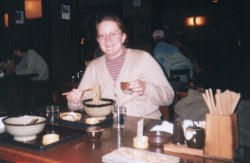 |
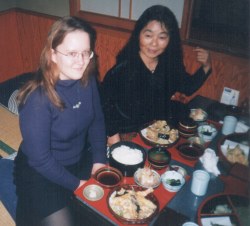 |
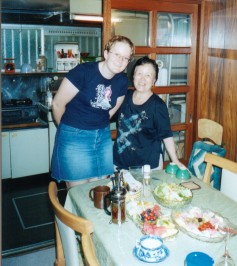 |
| This is soba, skinny wheat noodles in broth.
This was a delicious meal after spending a day mountain walking. Soba
often comes in a meal set and was accompanied by tempura (fried vegetables
in batter). |
This meal was enjoyed with my teacher Kazuko.
It consisted of oyakudon (egg and vegetables mixed on rice), tempura, rice
and miso soup. |
My friend Yoshi
and his mother went to great trouble to find different kinds of cheese,
olives salami and fruit as that is what I gave them as an entree at a BBQ
in Australia. |
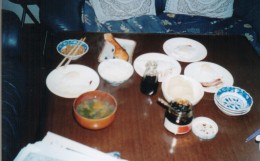 |
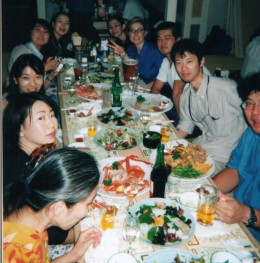 |
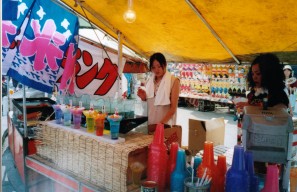 |
| My favourite
Japanese breakfast- salmon, tofu, natto, miso soup, egg, bacon and rice. |
Izakaya, a cheap place to eat and drink. This was a meal
set with lots of sashimi, crab, fried chicken and salad. |
Ice drinks at a
summer festival. Unfortunately I didn't feel like trying one as the vendors
had a cigarette in one hand while they were making food, dropping
ash everywhere. |
|
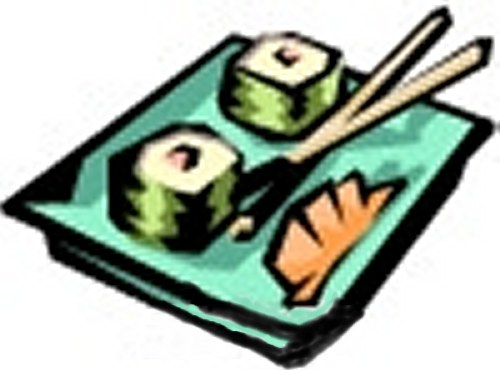
Back to Japan Index
|

Back to Index |














